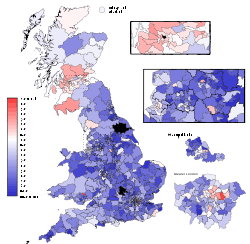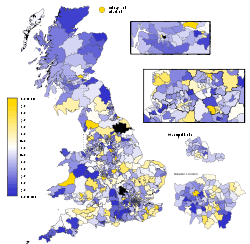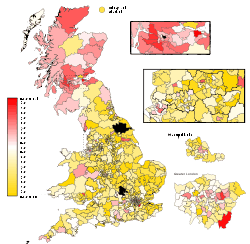Swing (politics)
An electoral swing analysis (or swing) shows the extent of change in voter support, typically from one election to another, expressed as a positive or negative percentage. A multi-party swing is an indicator of a change in the electorate's preference between candidates or parties, often between major parties in a two-party system. A swing can be calculated for the electorate as a whole, for a given electoral district or for a particular demographic.
A swing is particularly useful for analysing change in voter support over time, or as a tool for predicting the outcome of elections in constituency-based systems. Swing is also usefully deployed when analysing the shift in voter intentions revealed by (political) opinion polls or to compare polls concisely which may rely on differing samples and on markedly different swings and therefore predict extraneous results.[1]
Calculation
A swing is calculated by comparing the percentage of the vote in a particular election to the percentage of the vote belonging to the same party or candidate at the previous election.
One-party swing (in percentage points) = Percentage of vote (current election) − percentage of vote (previous election).
Example
Labor Party 51% (this year) less Labor Party 41% (four years ago) means the Labor Party saw a swing of 10 points (this implies in their favour and can also be published as +10 points).
Examples include the comparison between the 2006 and 2007 Ukrainian Parliamentary elections.
The above charts show the change in voter support for each of the six major political parties by electoral district and nationwide vote results.[2]
Two-party swing
In many nation states' media, including in Australia and the United Kingdom, swing is normally expressed in terms of two parties. This practice is most useful where most governments tend to be from an existing two-party system but other candidates do sometimes run, and is used to predict the outcome of elections in constituency-based systems where different seats are held with different previous levels of support. An assumption underlies extrapolated national calculations: that all districts will experience the same swing as shown in a poll or in a place's results. The advantage of this swing is the fact that the loss of support for one party will in most cases be accompanied by smaller or bigger gain in support for the other, but both figures are averaged into one. Employing the two assumptions allows the analyst to compute an electoral pendulum, predicting how many (and which) seats will change hands given a particular swing, and what size uniform swing would therefore bring about a change of government.[3][4][5]
Australia
In Australia, the term "swing" refers to the change in the performance of a political party or candidate in an election or opinion poll. As Australia uses the preferential voting system, swing can be expressed in terms of the primary vote (first preference vote), or in terms of the two-party-preferred or two-candidate-preferred result, which may represent significantly different values due to preference flows; ie a 5% primary vote swing does not necessarily represent an equivalent swing in TPP or TCP terms.
United Kingdom
In the UK a two-party swing (averaged model) is generally used, which adds one party's increase in share of the vote (expressed as a percentage point) to the percentage-point fall of another party and dividing the total by two.
So if Party One's vote rises by 4 points and Party Two's vote falls 5 points, the swing is 4.5 points (Party 2 to Party 1).[6] For disambiguation suffixes such as: (Con to Lab) (Lab to Lib Dem) (Lib Dem to Con) must be added where three parties stand. Otherwise a problem when deciding which swing is meant and which swing is best to publish arises where a lower party takes first or second; or where a party loses one of the top two places.[n 1]
Originating as a mathematical calculation for comparing the results of two constituencies,[n 2] any of these figures can be used as an indication of the scale of voter change between any two political parties, as shown below for the 2010 United Kingdom general election:
 Labour to Conservative swing
Labour to Conservative swing Liberal Democrat to Conservative swing
Liberal Democrat to Conservative swing Labour to Liberal Democrat swing
Labour to Liberal Democrat swing
United States of America
Swing in the United States can refer to swing state, those states that are known to shift an outcome between Democrats and Republican Parties, equivalent on a local level to marginal seats. By contrast, a non-swing state is the direct equivalent of a safe seat, as it rarely changes in outcome. The extent of change in political outcome is heavily influenced by the voting system in use.[n 3]
Three party swing or greater
Some websites provide a pie chart based or column-based multi party swingometer where ± x%, ± x%, ± x% and so on is displayed or can be input for three parties (or more in more plural democracies). This tool or illustration provides likely outcomes wherever more than two political parties have a significant influence on which politicians are elected.[7]
See also
Notes and references
- Notes
- E.g. a Liberal Democrat drops from first to third place and a Conservative Party former runner-up wins to a Labour Party runner-up who was in third place, here three interesting swings are relevant: Lib Dem-Con, Lib Dem-Lab and Lab-Con (and their opposite sign (+/-) equivalents for the opposite way swings).
- Britain, like the US, uses a first-past-the-post voting system and where a new third party or independent candidate has a better or worse result (or stands or chooses not to) this calculation allows for a more understandable comparison between the parties which are of wider interest.
- As in the UK, the US employs a first-past-the-post voting system as its main voting system.
- References